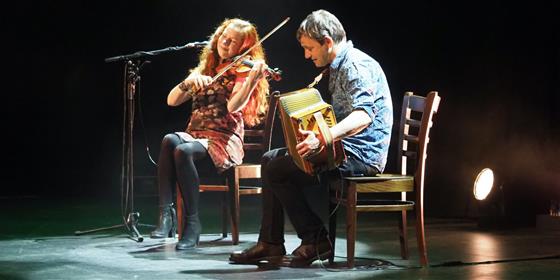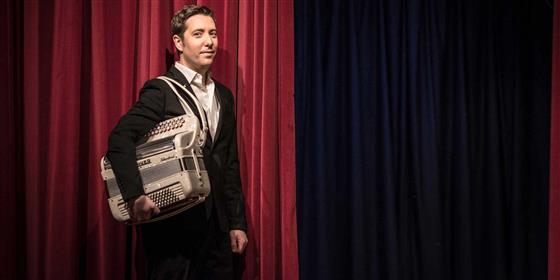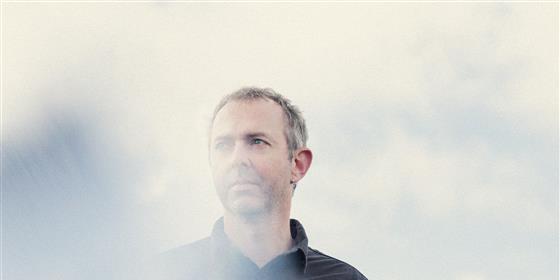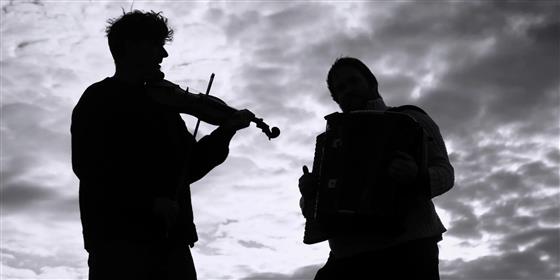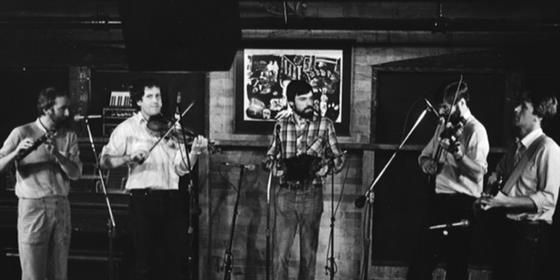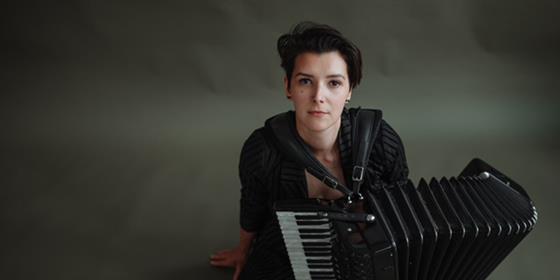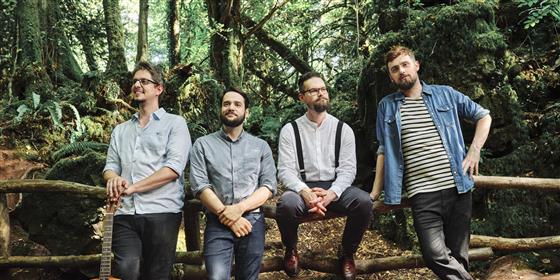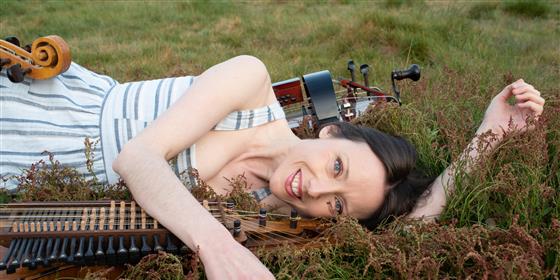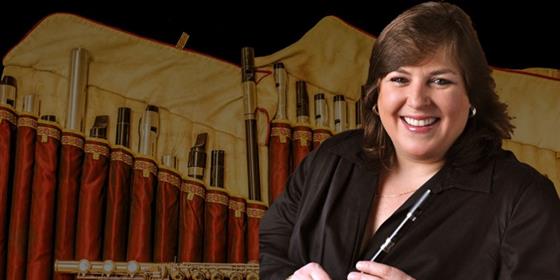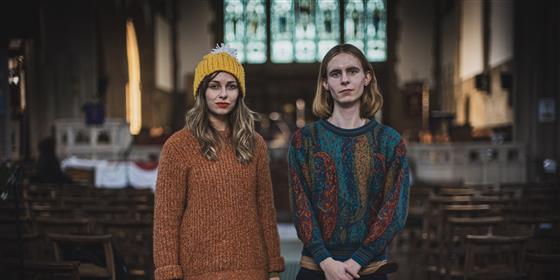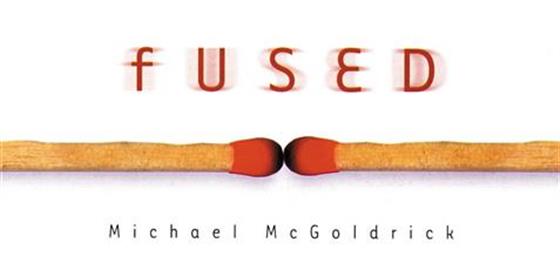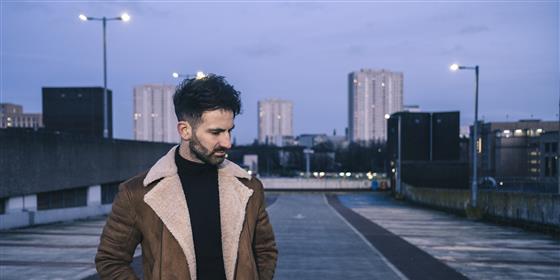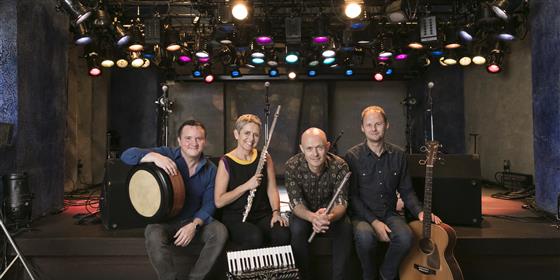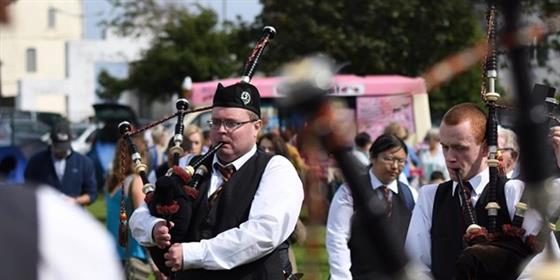Posted by Michele Mele 10 April 2024
On his 2019 album Field and Dyke with guitarist, singer and songwriter Greg Russell, songwriter and accordion and hurdy-gurdy player Danny Pedler explores the history, landscape and human geography of the Fens, the vast and underrated area of Eastern England surrounding the Wash and spanning four different counties. This young musician, also known for being part of spellbinding trio Tarren, concentrates particularly on the mostly agricultural area of South Lincolnshire, an often overlooked district with a wealth of captivating history, food and architecture.
The album includes all self-penned songs plus two instrumentals, sometimes accompanied by the wise and never overwhelming use of machine sounds, and samples of the many interviews Pedler carried out with people living in Lincolnshire. Russell’s storytelling talent and Pedler’s poignant lyrics, the result of deep field research, and instrumental touch paint a vivid fresco of the people, including the many immigrants, who have shaped the low, open and marshy plains.
Pedler has been so kind as to answer a few questions for Bright Young Folk readers and to give us some exclusive news about a future project that promises to be an equally engaging and meaningful work.
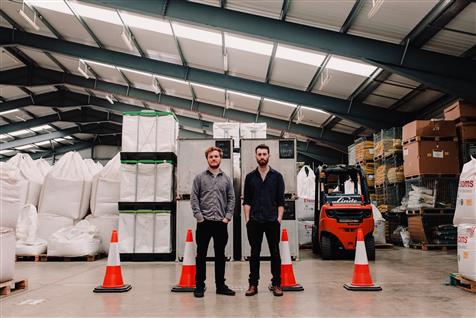
How did you pick up the accordion and the hurdy-gurdy?
Morris dancing has a lot to answer for. High amongst its crimes is that it was the backdrop for my parents’ meeting and then the reason for many a day out in my youth where I was forced to follow various rag-tag groups of musical wombles.
However, it meant that I grew up surrounded by English traditional music where the lumpy tunes are designed to lift the dancers off their feet. This pulse of Morris tunes has formed my musical taste and the influence pervades everything I create.
The melodeon would have been a more obvious choice of instrument to play this kind of music on; accordion music usually has a smoother style of playing since the player does not have to change the direction of the bellows as often. Having grown up playing the piano, I fell quite naturally into playing the accordion, however. My style of playing attempts to emulate the rhythmic lift of English traditional music.
The Hurdy-Gurdy is a French traditional instrument and my playing of that is purely down to me being a weird teenager. I was taught by the wonderful maker and player Mike Gilpin who lived on the edge of the Cambridgeshire Fens.
How did you meet Greg Russell? And how did your collaboration start?
I knew of Greg’s work before the inception of the project and I admired his vocal power. When the idea for Field and Dyke came about, I wanted someone who could give suitable weight to the emotion that I knew the songs would contain.
After collecting the interviews that were to become the heart of the project and had written the first song of the album, Down and Deeper, I sent Greg an email. I asked him if he was interested in lending his voice and songwriting prowess to the project that had not got full funding from Arts Council England. We met and he took a gamble on the project for which I will be eternally grateful.
Why were you in the first place interested in the human, social and agricultural history of South Lincolnshire?
I had grown up reading and listening to folk stories and the ones that captured my imagination most were those that were set in this slightly odd area that I knew was near where I lived. This place was called the Fens. Historically a far-reaching marshland, these Fenland stories had an eerie lilt to them: other-worldly lights appearing out of the night-time mist, bone-chilling howls from unseen animals, odd creatures that lured travellers to their death in the marsh.
Since medieval times various human endeavours have drained the Fens to be the arable farmland of Lincolnshire, Cambridgeshire and Norfolk. The result is a fertile, flat landscape where is huge skies stretch for miles. There is a certain beauty to this duality that seems to grab my attention. The fact that it is a manufactured landscape made me want to know more about the people that drained the land. Who were they? Why did they do it? Did people protest this change?
As part of the Field and Dyke project, I wrote a history of the Fens which is available to buy on the Pedler // Russell website.
The album is full of exceptionally descriptive passages, many of them leave a profound trace in the listener’s mind; some lines could have been the basis for equally good titles for this release. Take for example “Water Makes This Land”, “Where We All Belong” or “In Fenland Soil”. Why did you choose the title Field and Dyke?
The name of the project paints a picture of the Fens. There are huge, far-ranging fields planted with all kinds of crops, sowed in the rich, peaty soil. Dykes are the waterways surrounding fields where the drained water can run into so as to not waterlog the fields.
Everything is linked to the land in south Lincolnshire. I interviewed a range of people but everyone had a different outlook on the flat landscape and the abundance of water. From poetic quotes like ’I looked across (the wash), and I could see silver’, but also to the mundane observations like how easy it was to cycle around.
There is a saying that I love from the Fens that the land is so fertile that if you leave your garden fork in the ground overnight, in the morning it would have roots growing from it. This image was interpreted by wonderful artist Neil Baker (electricegg.com) for the Field and Dyke album artwork.
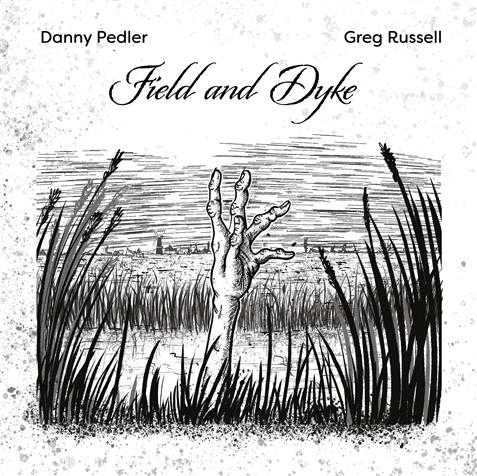
There’s a number of songs in the English folk tradition describing agricultural work dating back to the 19th century. And Field and Dyke uses a similar format to Ewan MacColl and Peggy Seeger’s radio ballads to describe working life through the mixture of original song and recordings of real people telling their story. Did you and Greg consciously go back to either of these sources for the project, or was your aim to head in a new direction?
One of the main ideas for the project was that we needed to write new songs as there have been no songs collected in South Holland district, South Lincolnshire that we can trace as originating from there. This is a discrepancy as there are unique folk songs collected all across the British Isles. We wanted to use modern-day stories, collected in the interviews, to create new folk songs that told the story of today.
I think this is so important to write narrative songs, in the folk style, that reflect modern society. Otherwise we fall into thinking that folk music is just about people from centuries ago. I believe strongly that it can be a voice for the people and be a unifying force.
Many people, including some of the Edwardian-era collectors or writers of music hall “folk” songs perpetuated the stereotype of the jolly farmhand and a disappearing rural idyll, which has gone a long way to shaping the repertoire sung on the folk scene today. How do the scenes described in these songs match up to your experiences of speaking to agricultural workers today?
I think folk song is a beautiful medium which can genuinely reflect the interests of social groups or trades be it farmers, miners, sailors, dockers, soldiers or even pedlars. Songs were mostly written by, and from the viewpoints of, the lower classes which gives an authentic insight into what life was like centuries ago.
Songs like Rigs of the Time tell us of the hardships faced by the poor, and others like Poverty Knock poetically illustrate working conditions in factories. Many experiences (the hard work, the monotony etc.) stay the same when I speak to modern day farmers, fruit pickers and factory workers, however the relevance of folk music has almost completely departed the modern working class because the modern working class are not represented in folk song.
The romantic view of a white, English working class doesn’t exist in the 21st century, so our folk songs need to adapt to reflect this change. I often hear politicians talking of protecting ’hard working families’ while also spouting hate-speech regarding on migrants and foreign nationals which make up a great deal of the working poor in modern-day Britain. They are guilty of what the early folk collectors were guilty of - choosing who or what to represent without looking at the full picture.
I see great strides in representing diversity of sexuality and gender in modern Folk music from artists and groups like Maddie Morris, Queer Folk, Malin Lewis etc., and more work is needed to make folk music an inclusive scene where culturally diverse artists can tell their stories and make folk music more representative of modern society.
I think the folk collectors of the late 19th and early 20th centuries achieved their goal of embedding folk music in a more institutionalised and academic place where folk dance and music is a pursuit of the white middle class. The scene tends to hark back to a golden age, rather than look at the present. A great book to read on the folk collectors is The Imagined Village by Georgina Boyes.
Were there any interesting, amusing or memorable episodes or incidents that stand out from your research in South Lincolnshire?
Greg and I were interviewed by the BBC to feature on the evening news and we took the researcher on the Spalding water taxi where one of our interviewees, who the song Pigeon End is written about, drove us up the river Welland. We kept veering all over the river getting quite close to the reed banks because he was trying to look casual, steering the boat with his elbow while talking to the BBC researcher. Greg and I were quietly cracking up in the background.
Are there any distinctive or picturesque towns or villages, you have explored in this area, particularly those off the beaten track, that you recommend visiting after listening to Field and Dyke to get a sense of the scenes described on the album?
I would recommend visiting Crowland and Cowbit which are very old settlements dating back to medieval times. The ruined abbey in Crowland is beautiful.
If you stand with your back to Cowbit church and look across the fields to the south of the village, you see a flat floodplain which was regularly flooded in the past. In the track Water Makes This Land, a drainage engineer with a brilliant Fenland accent tells you how the flooded fields used to gleam in the sun. He says when he looked across the bank, he ’could see silver’.
The majority of the tracks on Field and Dyke are compositions of yours. Which among the ones you wrote, is the one you are more proud of? And why?
I am proud of the song-writing in Pigeon End as I think it is a concise, personal story which escapes my youthful over-writing which is present across the album! A lot of people have said that this song touches them emotionally which is such a wonderful compliment.
The title track Field and Dyke will always be my favourite, however. The melody was written to the sound of the pizza sauce machine that features throughout the track; you can’t have one without the other. This song represents the spirit of the album most completely.
A little bird told me there is something new coming in the near future. Would you like to tell us more about your next project?
More news to come but I am in the planning stages of a new project, using the Field and Dyke process, in Somerset. While Field and Dyke wanted to create new Folk songs to fill the void of original material in south Lincolnshire, I want this new project to create modern songs that can add migrants’ stories to the rich Somerset Folk tradition.
I am attempting to get funding for this project in this time of scarcity for arts funding so do bear with me! If you are interested in this new project, please sign up to the Pedler // Russell mailing list and I will keep you updated.
I have some wonderful, top top, musicians who are keen to work with me in this next project, but funding will have to come before any announcement!
See all of Bright Young Folk's text interviews.
